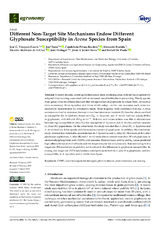Mostrar el registro sencillo del ítem
Different Non-Target Site Mechanisms Endow Different Glyphosate Susceptibility in Avena Species from Spain
| dc.contributor.author | Vázquez-García, José Guadalupe | |
| dc.contributor.author | Torra, Joel | |
| dc.contributor.author | Palma-Bautista, Candelario | |
| dc.contributor.author | Bastida, Fernando | |
| dc.contributor.author | Alcántara-de la Cruz, Ricardo | |
| dc.contributor.author | Portugal, João | |
| dc.contributor.author | Jorrin Novo, J.V. | |
| dc.contributor.author | De Prado, Rafael | |
| dc.date.accessioned | 2023-03-07T07:52:37Z | |
| dc.date.available | 2023-03-07T07:52:37Z | |
| dc.date.issued | 2023 | |
| dc.identifier.uri | http://hdl.handle.net/10396/24893 | |
| dc.description.abstract | In recent decades, cereal agriculture across main producing areas in Spain has progressively adopted direct sowing, associated with an increased use of herbicides in pre-sowing. Weedy species from genus Avena have been observed after the application of glyphosate in wheat. Here, Avena fatua (two accessions), Avena byzantina and Avena sterilis subsp. sterilis, one accession each, were taxonomically characterized by a biometric study. Dose-response trials confirmed that one A. fatua accession evolved to resistance, because it was four times more resistant (R) than the others, ascribed as susceptible (S). In addition, based on LD50, A. byzantina and A. sterilis had low susceptibility to glyphosate, with 604 and 458 g ae ha−1. Shikimic acid accumulation was able to discriminate between high susceptible (A. fatua (S)), low susceptible (A. byzantina and A. sterilis), and low resistant (A. fatua (R)) populations. On the other hand, the study revealed that A. fatua (R), A. byzantina and A. sterilis had low foliar uptake and decreased movement of glyphosate. In addition, the metabolism study showed less metabolite accumulation in A. byzantina and A. fatua (S). However, at 96 h after glyphosate application, A. fatua (R) and A. sterilis were able to convert more than 30% of glyphosate to aminomethylphosphonic acid (AMPA) and sarcosine. Enzyme basal activity and I50 values predicted high affinity between the herbicide and the target enzyme for all accessions, thus indicating that a target-site (TS) mechanism is probably not involved in the differences in glyphosate susceptibility. In closing, non-target site (NTS) mechanisms could participate both in A. fatua R to glyphosate, and low susceptibility in A. byzantina and A. sterilis from Spain. | es_ES |
| dc.format.mimetype | application/pdf | es_ES |
| dc.language.iso | eng | es_ES |
| dc.publisher | MDPI | es_ES |
| dc.rights | https://creativecommons.org/licenses/by/4.0/ | es_ES |
| dc.source | Agronomy, 13(3), 763 (2023) | es_ES |
| dc.subject | EPSPS | es_ES |
| dc.subject | Weed management strategies | es_ES |
| dc.subject | Plant evolution | es_ES |
| dc.subject | Plant resistance | es_ES |
| dc.subject | Pre-sowing | es_ES |
| dc.title | Different Non-Target Site Mechanisms Endow Different Glyphosate Susceptibility in Avena Species from Spain | es_ES |
| dc.type | info:eu-repo/semantics/article | es_ES |
| dc.relation.publisherversion | https://doi.org/10.3390/agronomy13030763 | es_ES |
| dc.rights.accessRights | info:eu-repo/semantics/openAccess | es_ES |

